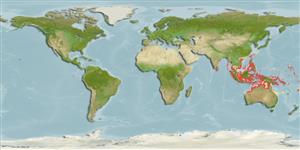>
Eupercaria/misc (Various families in series Eupercaria) >
Labridae (Wrasses)
Etymology: Paracheilinus: Greek, para = the side of + Greek, chaite = hair + Greek, odous = teeth (Ref. 45335).
Environment: milieu / climate zone / depth range / distribution range
Ekologi
laut berasosiasi dengan karang; kisaran kedalaman 5 - 35 m (Ref. 9710), usually 10 - 25 m (Ref. 48636). Tropical; 24°C - 28°C (Ref. 27115)
Indo-Pacific: Similan Islands, Andaman Sea and Christmas Island in the eastern Indian Ocean; Kranket Islands, Madang, New Guinea; off Manado and Celebes (Indonesia); Concoro Islands, Cuyo Islands, Philippines, and the Solomon Islands (Ref. 2139). Ryukyu Islands, Taiwan, Palau, and the Great Barrier Reef (Ref. 9823).
Size / Weight / umur
Maturity: Lm ? range ? - ? cm
Max length : 15.0 cm SL jantan/; (Ref. 9823)
deskripsi pendek
Kunci identifiaksi (pengenalan) | Morfologi | Morfometrik
Duri punggung (Keseluruhan (total)) : 9; duri punggung lunak (Keseluruhan (total)) : 11; Duri dubur: 3; Sirip dubur lunak: 9; vertebrata, bertulang belakang: 25. Emarginate caudal fin become lunate in males; 2-6 soft dorsal rays of males greatly prolonged (the odd-numbered rays beginning with the first); may be slightly prolonged in females (not so in Philippine adult females); non filamentous rays approximately equal in length (Ref. 2139). Tubed peduncular scales 5.9; side of body with four or five narrow red to blue stripes, only the first and third extending full length of body (Ref. 41634).
This group may consist of several different species and genetic studies are required (Ref. 90102). Found in rubble areas in passages and outer reef slopes. Also occurs in lagoons. Feeds on zooplankton and other benthic invertebrates. Occurs in small to large groups of mix sexes but females outnumber males greatly. Some geographical variations of nuptial males that are influenced by the presence of similar species. Males readily display to each other or to females to spawn by flashing their colors and 'racing' past with erected fins. Hybridizes with several other species, and are most colorful where other similar species occur in the same area (Ref. 48636). At 15 cm SL, this could well be the largest species of the genus so far (CB).
Life cycle and mating behavior
Kematangan | Reproduksi, perkembang biakan | Pemijahan | telur-telur | Fecundity | Larva
Oviparous, distinct pairing during breeding (Ref. 205).
Randall, J.E. and R. Lubbock, 1981. Labrid fishes of the genus Paracheilinus, with descriptions of three new species from the Philippines. Jap. J. Ichthyol. 28(1):19-30. (Ref. 2139)
Status IUCN Red List (Ref. 130435: Version 2024-1)
ancaman kepada manusia
Harmless
penggunaan manusia
Perikanan: tidak ada kepentingan; Akuarium: Komersial
Alat, peralatan
laporan khas
muat turun XML
Sumber internet
Estimates based on models
Preferred temperature (Ref.
123201): 26.4 - 29, mean 28.2 °C (based on 398 cells).
Phylogenetic diversity index (Ref.
82804): PD
50 = 0.5000 [Uniqueness, from 0.5 = low to 2.0 = high].
Bayesian length-weight: a=0.00977 (0.00470 - 0.02030), b=3.07 (2.90 - 3.24), in cm total length, based on LWR estimates for this (Sub)family-body shape (Ref.
93245).
Trophic level (Ref.
69278): 3.4 ±0.45 se; based on food items.
Daya lenting (Ref.
120179): Tinggi, Waktu penggandaan populasi minimum kurang dari 15 bulan (Preliminary K or Fecundity.).
Fishing Vulnerability (Ref.
59153): Low vulnerability (10 of 100).
Nutrients (Ref.
124155): Calcium = 85.9 [50.1, 156.1] mg/100g; Iron = 0.807 [0.463, 1.541] mg/100g; Protein = 18.2 [15.3, 20.4] %; Omega3 = 0.153 [0.092, 0.254] g/100g; Selenium = 22.6 [13.1, 44.0] μg/100g; VitaminA = 240 [73, 866] μg/100g; Zinc = 1.65 [1.11, 2.60] mg/100g (wet weight);
